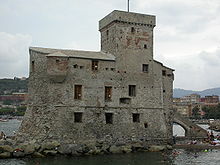Rapallo
| Comune di Rapallo | |
|---|---|
| Name | Rapallo |
| Region | Liguria |
| Province | Genoa (GE) |
| Altitude | 3 |
| Area cityproper | 33.70 |
| Population as of | 2005-12-31 |
| Population density | 30,224 |
| Population density metric | 897 |
| Timezone | CET, UTC+1 |
| Rrazioni | Sant'Andrea di Foggia Santa Maria del Campo San Martino di Noceto San Massimo San Maurizio di Monti San Michele di Pagana San Pietro di Novella San Quirico d'Assereto |
| Telephone | 0185 |
| Postal code | 16035 |
| Gentilic | Rapallesi |
| Saint | Our Lady of Montallegro |
| Day | July 2 |
| Mayor | Marco Melgrati (since 2006-05-30) |
| Website | www.comune.rapallo.ge.it |
| Mapx | 44.22 |
| Mapy | 9.22 |
Rapallo is a commune in the province of Genoa, in Liguria, Italy.As of 2003 it counts approximately 34,000 inhabitants, it is part of the Tigullio Gulf and is located in between Portofino and Chiavari.
The climate is moderate and the main part of town is on fairly level land. Many of the villas are built in the hills that rise immediately behind the city to protect them from strong northern winds.
History
The first settlement dates probably from the 8th century BC, although the findings have not cleared if it was of Etruscan or Greek origin.
Conquered by the Lombards in 643, the village of Rapallo was included in the county of Genoa under Charlemagne. The name of the city appears for the first time in a document from 964. In 1203 the Podestà of Rapallo was created, which in 1229 it became a Genoese dominion. Galleys from Rapallo took part to the famous Battle of Meloria of 1284. On September 5, 1494 it was captured by the Aragonese, but three days later 2,500 Swiss troops ousted them.

During the 16th century it was attacked and sacked by the Ottomans and Barbary pirates; to help defending the village against such attacks a castle was built on the seafront. In the late 18th century it was captured by the French who, after several clashes against Austro-Russian troops, in 1805 annexed it to the Apennins département. In 1814 the English freed it, and the following year the city was given to the Kingdom of Sardinia-Piedmont.
In late 1917, an Anglo-Franco-Italian conference met at Rapallo following the disastrous Italian defeat at Caporetto. It was decided to create a supreme war council at Versailles and to shift some French and British troops to the Italian front. On November 12, 1920, Italy and the Kingdom of the Serbs, Croats, and Slovenes (later renamed Yugoslavia) signed the Treaty of Rapallo, which resolved the frontier issues between them without reference to the other Allies. Italy acquired the strategically important crest of the Julian Alps as her boundary in the northeast. Also concluded at Rapallo was the Russian-German Treaty of Rapallo of April 1922, in which both countries renounced claims to war reparations and renewed diplomatic relations. This agreement marked the emergence of Russia and Germany from the diplomatic isolation caused by World War I (1914-1918).
During World War II numerous partisans from Rapallo were shot by German occupation troops.
Rapallo has been known for its climate that made it over the years the winter residence of preference for most of the affluent Italians living in the North West of Italy. Its proximity to the coast makes for mild winters where people can enjoy easy strolls on the sunny promenade and the golfers can enjoy one of the oldest courses in Italy, opened in 1930.
Friedrich Nietzsche wrote that the ideas for Zarathustra first came to him while walking on two roads surrounding Rapallo, according to Elisabeth Förster-Nietzsche in the introduction of Thomas Common's translation of Thus Spake Zarathustra.
Main sights
- The Castello sul Mare (Castle-on-the-Sea), erected in 1551 to counter the frequent pirate attacks. It include a small chapel dedicated to St. Cajetan, built in 1688.
- The Castello di Punta Pagana is a seat of the Sovereign Military Order of Malta. It was finished on July 28, 1631.
- The historical Tower of the Fieschi and the Torre Civica (1473).
- The Porta delle Saline, the only gate remained of the ancient walls.
- Basilica of Sts. Gervasius and Protasius, consecrated in 1118 and restored in the early 17th century. In 1679 a new apse was added, deleting the former Romanesque character of the edifice. It has a leaning bell tower.
- The church of St. Francis of Assisi (begun in 1519).
- The Sanctuary of Nostra Signora di Montallegro ("Our Lady of Montallegro", 1558-1640).
- The ruined Monastery of Valle Christi (13th century), abandoned in 1568 after pirate ravages.
Coat of arms
Rapallo's coat of arms is laurel leaves along with two yellow-colored eagles along with a yellow-colored crown on a blue shield. The blue reads Communi Rapalli, (the commune of Rapallo), and its crown is lemon-yellow crown with bricks[1].
The area includes the Parco Naturale Regionale di Portofino, encompassing the territory of six communes.
External links
| Regions of Italy | ||||
|---|---|---|---|---|
| Abruzzo • Aosta Valley • Apulia • Basilicata • Calabria • Campania • Emilia-Romagna • Friuli-Venezia Giulia • Lazio • Liguria • Lombardy • Marche • Molise • Piedmont • Sardinia • Sicily • Trentino-South Tyrol • Tuscany • Umbria • Veneto | ||||

